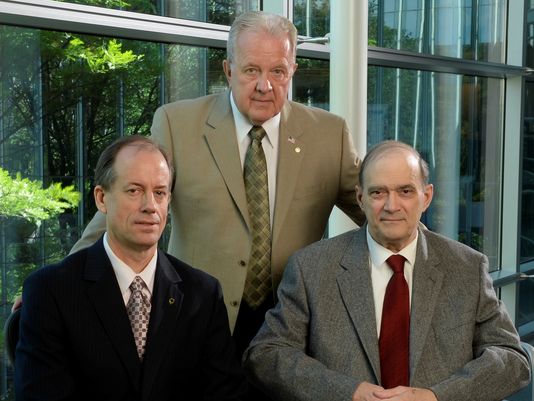Seventeen years after the Paris-bound TWA Flight 800 blew up off the coast of Long Island, producers Tom Stalcup and Kristina Borjesson have released a new documentary - simply titled "TWA Flight 800" - that has the very real potential to re-open the investigation into the plane's destruction.
Kudos, in particular, to Stalcup. A Ph.D. physicist by background, he has dedicated the last 16 years of his life to exposing what is arguably the most flagrant government cover-up in American peacetime history.
Borjesson has likewise been involved from the beginning. As a producer at CBS in 1996 when TWA 800 was destroyed, she sacrificed her future at CBS to get at the truth. Together, they have produced a documentary that is compelling, convincing and, finally, deeply moving.
Jack Cashill and James Sanders exposed the corrupt TWA 800 investigation in their book "First Strike" - get it now at WND's Superstore
The producers made two strategic moves to force the media to look seriously at their conclusions. One was to rely heavily on the testimony of a half-dozen highly credible whistleblowers from within the investigation.
The second was to avoid politics. When James Sanders and I produced the video documentary "Silenced" on this subject 12 years ago and the book "First Strike" two years after that, we made the marketing mistake of identifying the logic of the cover-up.
That logic led to the White House. Sixteen years ago, in the home stretch of a difficult re-election campaign, Bill Clinton faced a problem very similar to one that Barack Obama would face in 2012. This is something the media did not want to know, let alone share.
An event took place that threatened the "peace and prosperity" theme of his campaign - specifically, the shoot-down of this doomed airliner with 230 people on board 12 minutes out of JFK.
Although the word was not used back then, the Clinton White House, with the help of a complicit media, rewrote the event's "narrative" to assure re-election. Again, as with Benghazi, that narrative was clumsily improvised almost on a daily basis.
Knowing the media had his back, Clinton responded much as Obama did: deny, obfuscate and kick the investigatory can down the road until after the election.
One central figure appeared in each drama: Hillary Clinton. She stood by Obama's side in the Rose Garden on Sept. 12 as he spun reality into confection.
Throughout that long night of July 17, 1996, she holed up with Bill and Sandy Berger in the White House family quarters, assessing their narrative options much as Obama did on Sept. 11, 2012.
By removing politics from the equation, Stalcup, who appeared in "Silenced," and Borjesson have attracted a fair share of major media attention.
In their well-researched recreation of the plane's final minutes, they wisely refrain from saying who pulled the trigger. But the evidence that someone fired missiles at the plane overwhelms the dispassionate observer.




Comment: Cassiopaean session 23rh Nov. 1996
Q: (T) About Flight 800. Pierre Salinger claims that the info floating around on the internet is accurate. He says that the Navy downed the flight.
A: Close. Pierre Salinger is an impeccable journalist and not one to "fly off the handle."
Q: (T) Very true. And that is why I am amazed that the rest of the journalism community is attacking him.
A: Why should you be amazed? They are "bought and paid for."
Q: (T) What did happen to flight 800?
A: This was the result of an experiment gone awry. So was KAL "007" in 1983.
Q: (L) What was the nature of the experiment?
A: Testing of secret impulse guidance system using civilian airliner as an arbitrary "bounce" guidance target. Instead, it became the "homing" target, and a different aircraft became the bouncer. This was because the programmers did not anticipate the lower than expected altitude of the 747. Warning: this must stay in this room for the present!!!!!!!!!! The facts will eventually be discussed by others. At that time, the danger is lifted.
Now, about KAL 007... that one is not dangerous to know. The plane was deliberately instructed to fly off course in order to trigger the Soviet's Pacific air defense system, to "see what they were made of" in that area. The plane was lost, but the experiment worked. They did not expect them to shoot down a civilian airliner. Now, all moving targets create electronic impuses. These can be "read" by the proper extremely high tech equipment. Older radar guided systems are subject to malfunctions in weather conditions that are severe, as one example. Also, the impulse system is an offshoot of the electromagnetic pulse experiments being carried out at Montauk, Brookings and elsewhere as part of the HAARP project! In connection with Pentagon missile tests, HAARP has many interesting tie-ins, not the least of which is your cell phone towers. Now, the homing target can be any moving object. It can be whatever is entered on the computer. It can be a squirrel in a tree, a jogger on the beach, a building, whatever you want. The system looks for any moving target in order to establish recognition to the computer, in order to establish recognition of match pattern of pulse. TWA 800 was flying at the exact same altitude that was supposed to be designated for the "drone" craft. The drone plane was fartehr out at sea. The "bounce" target was to be any moving object in the air within 400 square miles.
Q: (L) So, TWA 800, through a series of problems, happened to find itself at the right altitude, a restricted altitude, within the parameters of the experiment. Anything further on this?
A: Not for now.